Digital Foundry's guide to the best PC controllers
Take control.
Mouse and keyboard remains the interface of choice for a wealth of PC games, but the bottom line is that there are plenty of titles out there that play better using a gamepad - to the point where it has become required kit. Our aim with this guide is pretty straightforward - we'll be testing every controller we can get our hands on, updating as new joypads arrive - and seeing how well they work for PC gaming.
In this initial post, we'll be covering off seven different pads we've used over the course of our PC gaming this year - and there are more to come. Logitech's F310 and F710 controllers are en route and we'll also be giving Nvidia's Shield controller a workout in due course. If you have any further suggestions for hardware you'd like to see added to the guide, please let us know.
But even in this initial post, we feel there's plenty of kit worthy of consideration, and we're going to kick off with a piece of hardware that some might say is a genuine design classic - a decade on the market and still going strong.
Xbox 360 controller: the best overall joypad for PC gaming
There are two basic iterations of the Xbox 360 controller of course - wired and wireless - and both of them are compatible with the PC. To utilise the pad's wireless functionality an inexpensive USB dongle is required, but from our perspective, it is actually the wired pad that offers the best combination of function and convenience.
The pad proved its worth across an extended console generation owing to its excellent analogue sticks and well-designed bumpers and triggers, its only real weakness coming in the form of a woefully poor d-pad. The fact that the original design still holds up today demonstrates the extent to which Microsoft's designers got it right back in the day. As you might expect, the controller also offers exceptional compatibility with the Xinput protocol used on virtually every PC title used today.
It's actually the wired version of the Xbox 360 pad that we recommend most strongly of all, simply by virtue of its unassailable plug and play qualities. No batteries required, no play and charge kits needed, you just attach it via USB and you're good to go. The durability of the pad is also beyond question - we have two examples in the Digital Foundry office bought at launch that are still used daily many years on. Aside from the dimples on the sticks wearing away, they play as good today as they did when we first bought them.
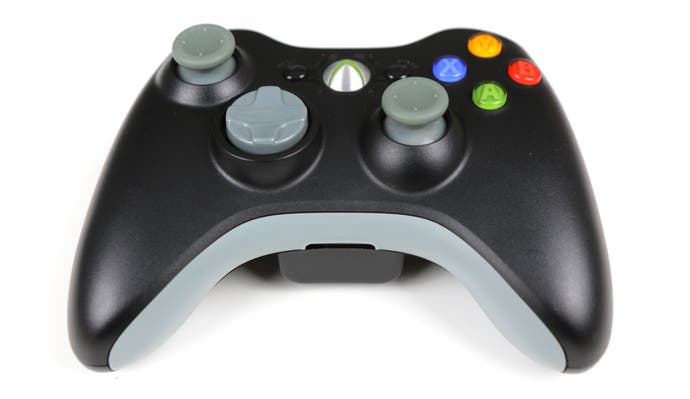
Order the PC-compatible Xbox 360 hardware covered in this article from Amazon:
Xbox One controller: improved in some areas, but not others
Of course, the Xbox 360 controller has been replaced now with the Xbox One successor and many believe it offers a superior experience overall - after all, that is what it was specifically designed for. Now, it may well be that our familiarity with the older pad is colouring our experiences here, but the newer model has done little to usurp its predecessor's standing as our joypad of choice. Utilisation of the newer features is sparse, but more than that, it's the fact that the Xbox One controller has attempted to merge wired and wireless functionality into one device that hasn't quite come off.
In common with many PC controllers, the Xbox One pad offers wired functionality via a micro-USB connection. In theory, this is a very good thing - the controller can be detached and used wirelessly at will, and if you run out of battery power, you can plug it back in easily enough using a readily available cable. However, our Day One Edition Xbox One controller failed within a year as the micro-USB socket effectively wore out. The only way it can used as a wired pad now is to hold the controller very, very still - and hope that the connection remains solid.
Of course, this will not happen to every pad, but it still feels like a design inadequacy. Joypads need durability - the Xbox 360 wired pad has that, the Xbox One controller hasn't.

Order the Xbox One hardware covered in this article from Amazon:
Dual Shock 4: a surprisingly good PC controller
By "surprisingly good", we aren't denigrating the Dual Shock 4's attributes as a controller as such, rather celebrating the fact that the controller can actually be used at all for PC gaming. Plugging in the pad directly via USB only offers very limited support with older DirectInput PC games - not the newer standard used on modern titles. In actual fact, the only way right now you can use the Dual Shock 4 with PC games is to download a third party piece of software called Input Mapper, taking the DS4s inputs and translating them into Xinput commands.
Input Mapper does a great job in translating across all of the analogue and digital interfaces on the Dual Shock 4 and the tool itself offers a lot of customisation options. It turns the standard PlayStation 4 controller into an impressive contender for the Xbox 360 pad's crown. It's also a really convenient piece of kit - and a lot of that is down to the fact that it is one of the few controllers to ship with a rechargeable battery as standard. Battery life isn't great but it's easily topped up via attaching a micro USB cable. It's also fully Bluetooth-enabled, meaning that no proprietary dongles are required for wireless functionality.
Disadvantages? Well, we're still not convinced at micro-USB's durability for wired play, and the rubberised controller sticks can wear away and perish quickly, depending on your play style. Also, in our Street Fighter 5 testing, we noticed considerable latency compared to the standard Xbox 360 wired pad. But if you own PS4 as well as a gaming PC, it's good to know that the pad you received free with your console works rather nicely on your computer too.
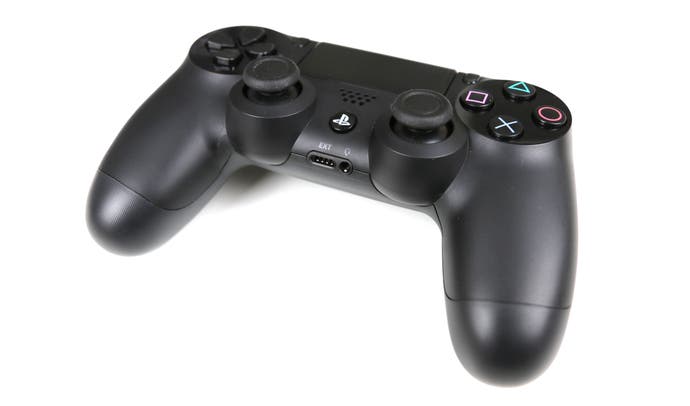
Order the Dual Shock 4 controller from Amazon:
Xbox One Elite controller: expensive, but brilliant
It's not cheap. In fact, it's hugely expensive. The Xbox One Elite controller is rather like a top-spec Apple laptop - you're not paying for the basic functionality offered by the machine (where cheaper options can do the same basic job), you're paying a radical upgrade in the experience of the user interface. The design is comfortable and easier to hold, despite being rather heavy, while the rubber underside surface offers plenty of grip. Build quality in general is on another level. It feels good, it feels special.
Two replaceable d-pads and three analogue stick tops are provided as standard, magnetically locking into place (no screwdriver required), offering the chance to adjust the pad on a hardware level to accommodate your play style. And yes, the d-pads do actually work well for fighting games. Additional underside paddles can be remapped to buttons for more intuitive reloads or gear-shifts, and again, the feel of the materials here is unsurpassed. Triggers stops are a nice feature too - reducing the travel and range of the analogue triggers and allowing you to fire more quickly in FPS titles, for example. Additional customisation options are also available in PC's Xbox One accessories app too, allowing you to further refine the experience.
If Microsoft produced a pure, wired version of this pad, it would easily take pole position as our choice pick. However, it's still using standard AA batteries for wireless functionality, wired connection is still via an unsubstantial micro-USB connection and the wireless receiver dongle only works on Windows 10.
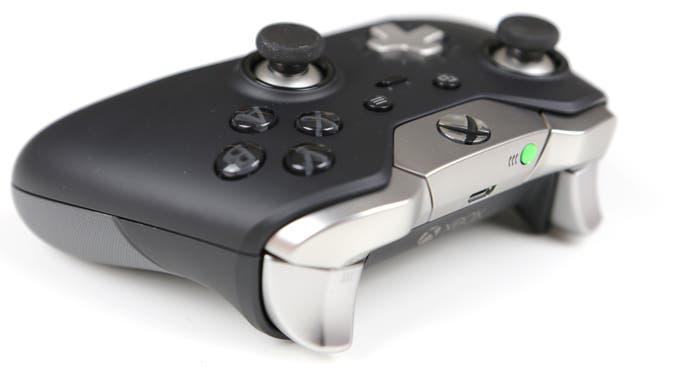
Order the Xbox One Elite hardware covered in this article from Amazon:
Razer Wildcat: premium pad with niche appeal
There is another premium price-point option - Razer's Wildcat. It doesn't quite get the same ringing endorsement as the Elite controller for a number of reasons, starting with build quality. Materials just don't have the same luxury finish as Microsoft's top-tier model, while additional thumbgrips supplied in the package are essential to eliminate slip on the sticks - something that just isn't needed at all on the standard Elite parts. The Microsoft pad's rubberised casing is also very good for grip while the Wildcat again goes for optional grips that are very difficult to attach without creasing the material. Removal and reapplication is not recommended as the adhesive could wear off. Additionally, the d-pad is disappointing - OK, but actually a regression over the standard Xbox pad.
Just like the Elite, there are a bunch of customisation and sensitivity options available, while additional triggers on the underside of the Wildcat can be used for switching weapons and reloading, leaving your thumb free for accessing other functions simultaneously via the standard face-buttons. And the face-button set-up is an aspect where the Wildcat scores over the Elite - they feel more mechanical in nature, with less travel required to activate the click. It's one of the highlights of the package. Also impressive is that audio functionality is built into the pad directly, whereas the Elite requires an add-on.
The Wildcat is a purely wired solution, and while the cable can be removed, it uses a far more durable interface than the Elite. It's also a lot lighter too, more in line with a standard Xbox One controller. It's a fine controller and we suspect that its distinct advantage will find favour with a niche group of players, but when the price-point is so similar to the Elite, it's difficult not to give the Microsoft controller the nod.
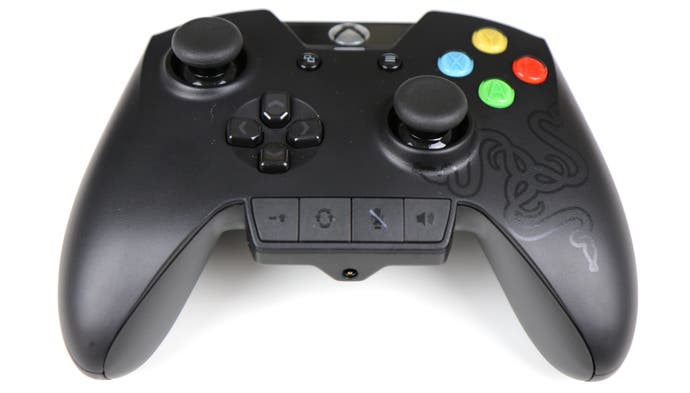
Order the Razer Wildcat controller from Amazon:
Steam Controller: best for customisation
When Valve began its Steam Machines initiative, it set out to answer a very specific challenge - to create a living room friendly controller perfectly equipped to handle every Steam title, meaning that not did the pad require Xinput support, it also needed to offer compatibility with mouse and keyboard games. It did this via the utilisation of two massive trackpads, offering innovative haptic feedback. On top of that, Valve effective open-sourced the controller, allowing the userbase to create new profiles for specific titles.
In terms of the sheer scale and ambition of this project, Valve deserves kudos - but the end result is very much a 'marmite' product you're either going to love or hate. We've put some time into the controller now, and just can't get over the intrusive nature of the right pad in particular. It dominates real estate to the point where accessing the face-buttons (the far left X button in particular) is a particular problem, especially for those with smaller hands. Game compatibility feels inconsistent, and you never quite know how well the controller will work on booting any particular game. It's also very Steam-centric, of course, and not so friendly for titles you may have in Origin, GOG or UPlay.
It's an innovative, cutting-edge piece of hardware you can have a lot of fun tinkering with, and many love it for this reason along with many others. We were impressed by the fact that Valve include the wireless receiver dongle as opposed to charging extra for it. However, while the customisation aspects are great, the bottom line is that we'd prefer just to plug in our wired Xbox 360 controller which is guaranteed to work on the vast majority of titles, and just get on with the gaming.

Order the Steam controller from Steam:
Zhidong V Plus: bargain basement - but does the job
In putting this piece together, we wondered whether we were missing a trick by restricting coverage to recognised brands. Would it be possible to get a good bargain - and a good product - by exploring cheaper brands. We chanced across the Zhidong V Plus after rummaging around Amazon. £15/$20 for a joypad is exceptionally cheap, and the customer feedback was compelling - 120 reports in total at the time of writing, with 88 five-star and 25 four-star reviews.
So does the product actually deliver? Well, you pay for what you get - the pad is weighty and substantial enough though plastics feel a little cheap. The face-buttons are perfectly serviceable and work fine, while the d-pad is something of a revelation - it's excellent, working beautifully on Street Fighter 5. Where things start to go awry is with the analogue sticks - again, they're serviceable but the deadzone feels somewhat large. It's the bumpers and triggers that really let the side down though: cheap and clicky and we're not entirely sure whether the triggers themselves are actually analogue or not. One nice touch we did like was the inclusion of a USB OTG cable for direct connection to Android and Windows mobile products.
Overall, the rapturous praise for the product does seem a little exaggerated. It offers solid enough value, but just £5 more gets you the wired Xbox 360 controller - and d-pad aside, it's superior in every way.
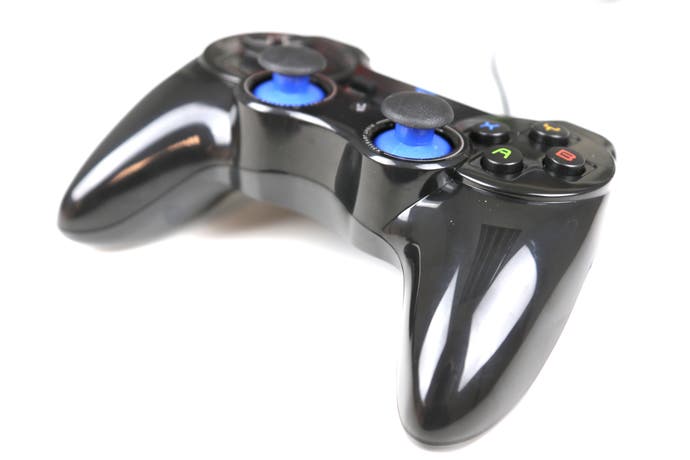
Order the Zhidong V Plus controller from:


